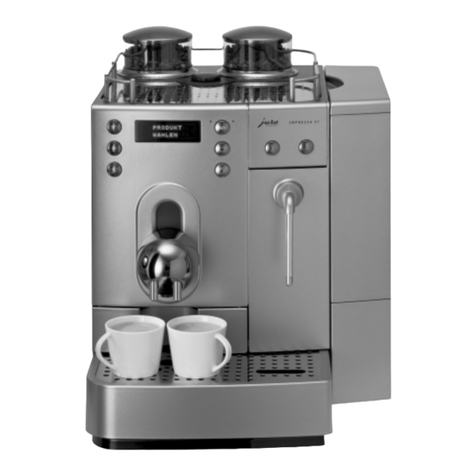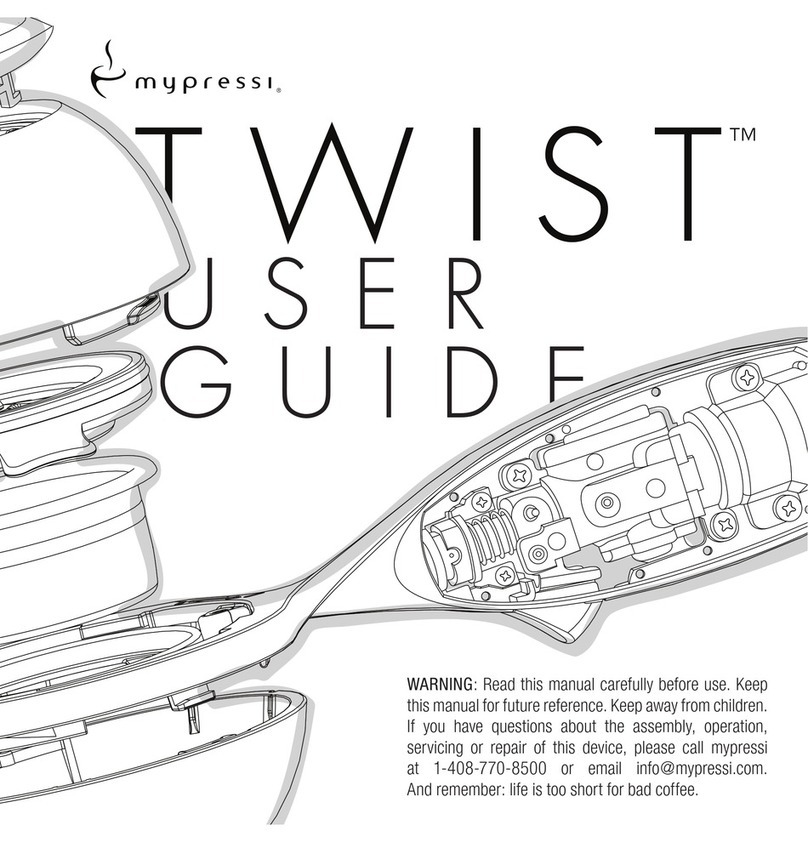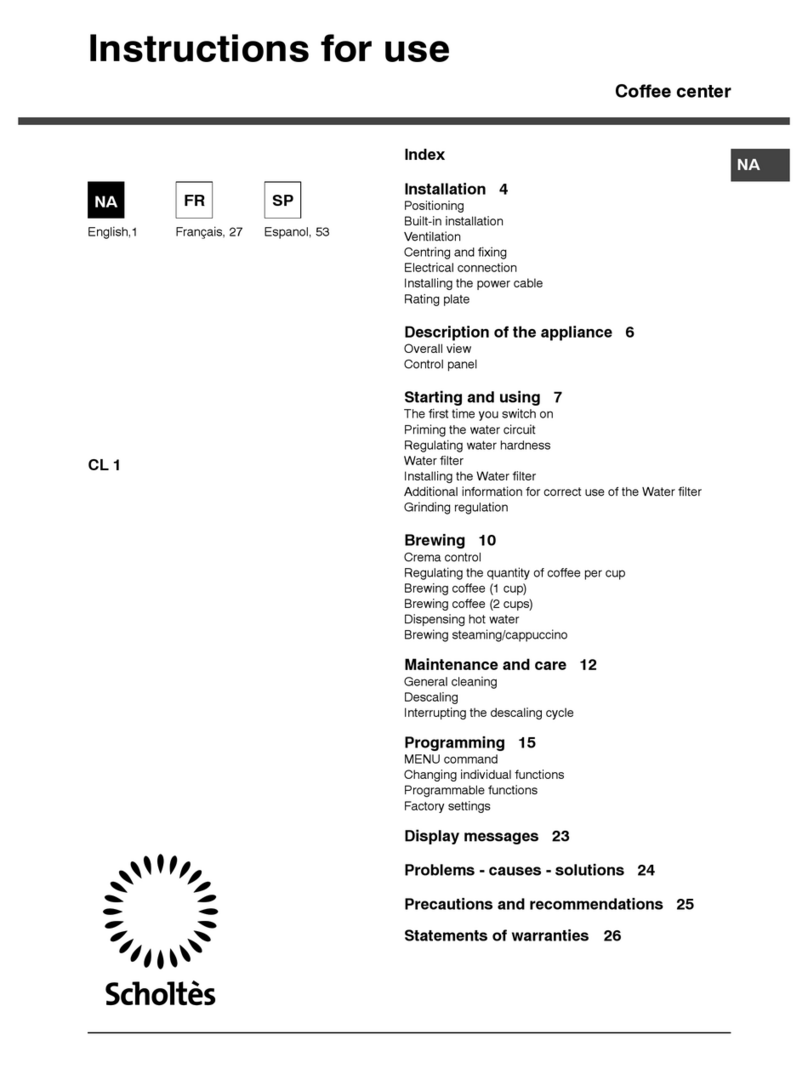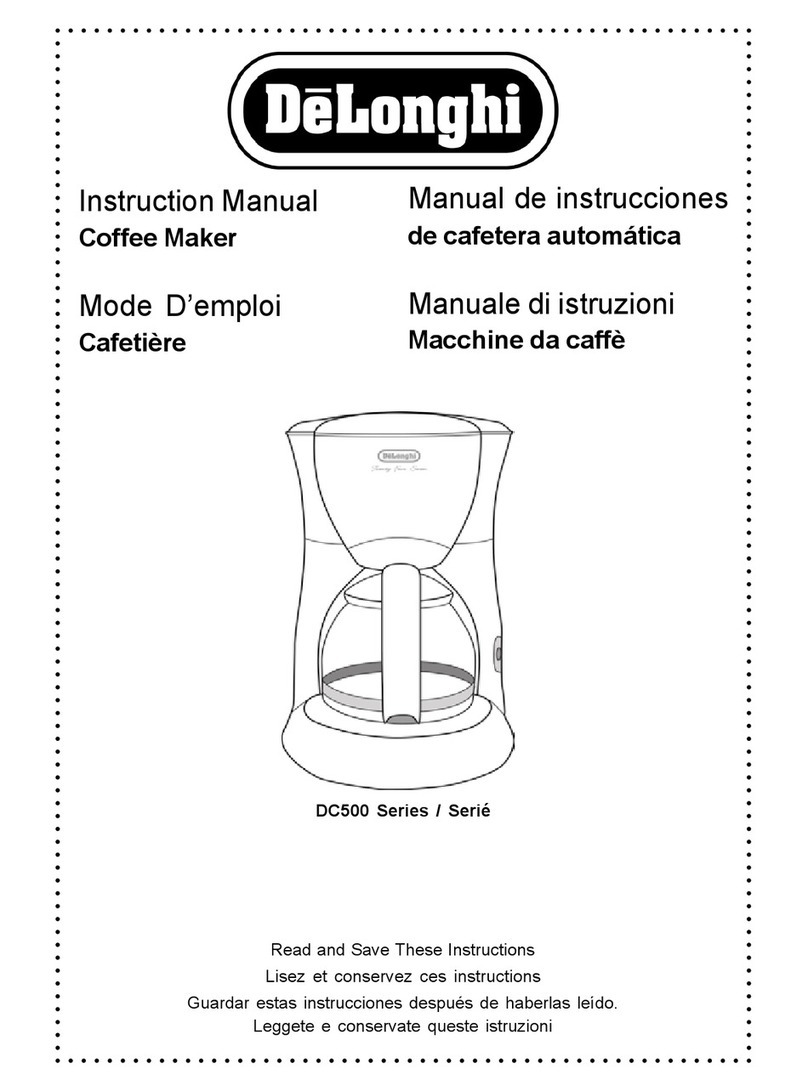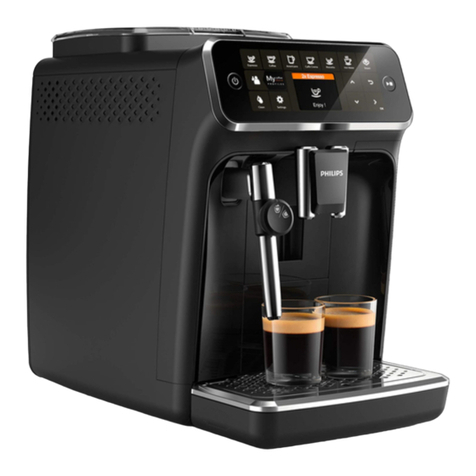Bon Appetit 9711 User manual

Bedienungsanleitung
Instructions for use
Mode d'emploi
Instruzioni per l’uso
Mod. 9711
DE
GB
FR
Chlor
IT
01_WIK_Umschlag_9711 22.06.2006 14:52 Uhr Seite 1

6 … 10
DE
11 … 15
GB
16 … 20
FR
21 … 25
IT
02_WIK_Umschlag_9711 22.06.2006 14:54 Uhr Seite 1

03_WIK_Umschlag_9711 22.06.2006 14:55 Uhr Seite 1

a
c
d
g
i
h
j
k
b
e
f
05_Rueckseiten_Einband 22.06.2006 14:57 Uhr Seite 1

7
10
8 9
1 2 3
4 5 6
11 12
06_Rueckseiten_Einband 22.06.2006 14:59 Uhr Seite 1

6
DE
CAFFÈ ESPRESS
Bezeichnung: Espressozubereiter -
schnurlos, mit Energie-
station
Modell: 9711
Spannung: 220 - 240 V ~ / 50 - 60 Hz
Nennaufnahme: 335 - 400 W
Heizsystem: Edelstahl-Heizplatte
Füllmenge: 0,3 Liter oder 6 Tassen
Netzleitung: max. 90 cm
Maße:
Höhe: 235 mm
Durchmesser: 120 mm
Max. zul. Druck: 4,0 bar
Schutzklasse: I
Funkentstörung: Dieses Gerät ist entspre-
chend den Funkentstörungsrichtlinien funk-
entstört.
EMV: Dieses Gerät ist entsprechend den
EMV (Elektromagnetische Verträglichkeit) -
Richtlinien entstört.
a
Edelstahl-Deckel
b
Öffnungshebel
c
Griff
d
Edelstahlkanne
e
Filterscheibe
f
Dichtung
g
Kaffeefilter mit Sieb
h
Sicherheitsventil
i
Edelstahlwasserbehälter
j
Ein-/Aus-Schalter mit roter
Heizkontrollleuchte
k
Energiestation mit Kabelstaufach
Die Bedienungsanleitung vermittelt Ihnen
wichtige Sicherheitshinweise und Informa-
tionen, die zum einwandfreien Betrieb des
Gerätes erforderlich sind!
Die Anleitung vollständig lesen, aufbewah-
ren und ggf. an Nachbesitzer weitergeben.
Alle Sicherheitshinweise dienen stets auch
Ihrer persönlichen Sicherheit!
Sicherheitshinweise beim Anschluss des
Gerätes
●Dieses Gerät entspricht den anerkannten
Regeln der Technik und den einschlägi-
gen Sicherheitsbestimmungen für Elek-
trogeräte!
●Um Schäden und Gefahren durch nicht
ordnungsgemäßen Gebrauch zu ver-
meiden, ist die Bedienungsanleitung zu
beachten und sorgfältig aufzubewahren!
●Bei Weitergabe des Gerätes an andere
Personen ist auch die Bedienungs-
anleitung mit zu übergeben!
●Bei Beschädigung der Netzkabels der
Energiestation darf diese nur durch eine
vom Hersteller benannte Reparaturwerk-
statt ersetzt werden, um eine Gefähr-
dung zu vermeiden. Bitte wenden Sie
sich an den Hersteller oder seinen Kun-
dendienst!
●Die Netzspannung muß mit der Span-
nungsangabe (V) auf dem Typenschild
der Energiestation übereinstimmen!
●Die Energiestation nur an Wechselstrom,
an eine Schutzkontaktsteckdose an-
schließen. Kabel dabei nicht über scharfe
Kanten ziehen, einklemmen oder herun-
terhängen lassen. Kabel vor Hitze und
Feuchtigkeit schützen!
●Netzstecker nur bei nicht aufgesetztem
Gerät einstecken!
Zu Ihrer Sicherheit!
Geräteelemente
Gerätekennwerte
07_Rückseiten f. Einband 22.06.2006 15:00 Uhr Seite 6

7
●Das Gerät darf nur mit der vorgesehenen
Energiestation betrieben werden.
●Das Gerät sowie die Energiestation nicht
auf heiße Oberflächen, wie z.B. Öfen,
Herdplatten, o. ä. abstellen!
●Netzkabel nie um das Gerät wickeln!
●Bei Verwendung eines Verlängerungska-
bels, nur ein geerdetes Kabel mit einem
Leiterquerschnitt von mind.
1,5 mm2 benutzen!
Sicherheitshinweise bei der Bedienung des
Gerätes
●Verwenden Sie das Gerät bestimmungs-
gemäß!
●Personen mit motorischen Störungen
sollten nie ohne Begleitperson das Gerät
in Betrieb nehmen, um eine Gefährdung
zu vermeiden.
●Kinder erkennen nicht die Gefahren, die
beim Umgang mit Elektrogeräten entste-
hen können, deshalb Kinder niemals
unbeaufsichtigt mit Elektrogeräten arbei-
ten lassen!
●
Verpackungsmaterialien, wie z.B. Folien-
beutel gehören nicht in Kinderhände!
●Betreiben Sie das Gerät nur, wenn sich
Wasser im unteren Edelstahlbehälter
befindet. Der Edelstahlboden verfärbt
sich und kann beschädigt werden, wenn
das Gerät ohne Wasser betrieben wird.
●Befüllen Sie den Edelstahlwasserbehäl-
ter ausschließlich nur mit Wasser.
●Achtung! Verbrühungsgefahr!
Austretender heißer Wasserdampf kann
zu Verbrühungen führen.
Deckel niemals bei der Espressozuberei-
tung öffnen. Gerät steht unter Druck!
Den Edelstahlwasserbehälter nie über
die max. zulässige Füllmenge befüllen!
Bei Überschreitung der max. zulässigen
Füllmenge wird heißer Wasserdampf
über das Sicherheitsventil abgelassen.
●Achtung! Verbrühungsgefahr!
Austretender heißer Wasserdampf kann
zu Verbrühungen führen.
Vergewissern Sie sich, dass das Sieb
und die Filterscheibe nicht verstopft sind.
Bei einem verstopften System wird der
max. zulässige Druck überschritten und
heißer Wasserdampf über das Sicher-
heitsventil abgelassen.
●Achtung! Verbrennungsgefahr!
Die Edelstahlbehälter werden während
der Espressozubereitung sehr heiß – dies
ist normal! Berührungen mit der Haut
können Verbrennungen verursachen.
Benutzen Sie zum Ausgießen ausschließ-
lich den Griff.
Sicherheitshinweise für die Reinigung und
Pflege
●Die Energiestation kann nicht geöffnet
werden.
●Bei Betriebsstörungen und bei der Reini-
gung und Pflege, Gerät von der Energie-
station nehmen und abkühlen lassen,
damit sich der innere Druck ausreichend
verringern kann! Netzstecker ziehen!
●Den Netzstecker nicht an der Leitung
oder mit nassen Händen aus der Steck-
dose ziehen!
●Achtung! Gefahr durch elektrischen
Schlag oder Kurzschluss!
Die elektrischen Teile sowie die Energie-
station vor Feuchtigkeit schützen! Den
Edelstahlwasserbehälter niemals in die
Spülmaschine stecken und nicht ins
Wasser tauchen!
●Achtung! Gefahr durch Überdruck!
Ein verstopftes Sicherheitsventil kann
dazu führen, dass der zulässige Druck
überschritten wird. Damit der Überdruck
entweichen kann, Sicherheitsventil auf
Verstopfung und Verschmutzung über-
prüfen und evtl. entkalken bzw. reinigen.
●Beachten Sie die Reinigungshinweise im
Kapitel „Reinigung & Pflege“!
08_Innenseiten_Sprachen 22.06.2006 15:02 Uhr Seite 7

8
Das Gerät ist ausschließlich zum Zuberei-
ten von Espresso- bzw. Mokkakaffee
bestimmt. Füllen Sie niemals Milch, Suppe,
Kaffee, Tee o. ä. in das Gerät.
Benutzen Sie für die Zubereitung aus-
schließlich gemahlenes Espressomehl und
keinen löslichen Kaffee, da dadurch das
System verstopft.
Bei Zweckentfremdung, falscher Bedie-
nung oder nicht fachgerechter Reparatur
wird keine Haftung für evtl. Schäden über-
nommen. Ebenso sind Garantieleistungen
in solchen Fällen ausgeschlossen.
Das Gerät ist nicht für den gewerblichen
Gebrauch bestimmt!
BILD 1
Vor dem ersten Gebrauch sollten Sie das
Gerät bei max. Füllmenge mindestens
zweimal auskochen. Den dabei zubereite-
ten Espresso nicht trinken!
Achtung! Verbrennungsgefahr!
Das Gerät wird während der Espresso-
zubereitung sehr heiß! Lassen Sie das
Gerät zwischen den einzelnen Brüh-
vorgängen vollständig abkühlen und
spülen Sie es mit kaltem Wasser aus.
Vorgang:
●Gewünschte Kabellänge an der Energie-
station
„k“
einstellen.
Nicht benötigtes Kabel auf die Kabelauf-
wicklung aufwickeln. Kabel an der Aus-
sparung herausführen (1).
●
Energiestation
„k“
bestimmungsgemäß
anschließen (siehe „Zu Ihrer Sicherheit“).
●Gerät in Betrieb nehmen (siehe „Espres-
so zubereiten“).
BILDER 2 – 12
Gerät befüllen
●Schrauben Sie die Edelstahlkanne
„d“
vom Edelstahlwasserbehälter
„i“
ab (2).
☛Hinweis
Vergewissern Sie sich, dass die Dichtung
„f“
und die Filterscheibe
„e“
sauber und
unbeschädigt und wie abgebildet in die
Kanne eingesetzt sind (3).
●Entnehmen Sie den Kaffeefilter
„g“
aus
dem Edelstahlwasserbehälter (4).
●Befüllen Sie den Edelstahlwasserbehäl-
ter
„i“
bis knapp unterhalb des Sicher-
heitsventils – dies ist die max. zulässige
Füllmenge (5).
Achtung! Verbrühungsgefahr!
Max. zulässige Füllmenge nicht über-
schreiten.
☛Hinweis
Falls Sie weniger Espresso zubereiten
möchten, beachten Sie die minimale Füll-
menge von 200 ml, was 4 Tassen Espres-
so entspricht. Ist diese Füllmenge unter-
schritten, wird der Kaffee evtl. zu kalt.
Bei maximaler Befüllung von 300 ml kön-
nen Sie 6 Tassen Espresso zubereiten.
50 ml entsprechen ca. 1 Tasse Espresso.
●Setzen Sie den Kaffeefilter
„g“
in den
Edelstahlwasserbehälter ein (6).
●
Bei der Zubereitung von 6 Tassen, füllen
Sie den Kaffeefilter
„g“
bis kurz unter den
Rand mit Espressomehl (7). Drücken Sie
das Espressomehl nicht an. Bei 4 Tassen
oder je nach Geschmack nehmen Sie ent-
sprechend weniger Kaffeepulver.
●
Säubern Sie den Rand des Kaffeefilters
von Espressomehl und schrauben Sie die
Edelstahlkanne, wie abgebildet handfest
auf den Edelstahlwasserbehälter auf (8).
Nehmen sie nicht den Griff zu Hilfe, um
den Behälter zu verschrauben, da dadurch
das Gerät beschädigt werden kann.
Espresso zubereiten
Erste Inbetriebnahme
Bestimmungsgemäßer Gebrauch
08_Innenseiten_Sprachen 22.06.2006 15:02 Uhr Seite 8

9
Achtung! Verbrühungsgefahr!
Heißer Dampf kann durch das Sicher-
heitsventil
„h“
entweichen! Achten Sie
darauf, dass sich das Sicherheitsventil
„h“
im verschraubten Zustand auf der
gegenüberliegenden Seite des Griffes
befindet.
☛Hinweis
Der Brühvorgang kann mit dem Ein-/
Aus-Schalter
„j“
jederzeit abgebrochen
werden.
Gerät einschalten
●Gerät auf die angeschlossene Energie-
station aufsetzen (9).
●Das Gerät bei geschlossenem Deckel mit
dem Ein- /Aus-Schalter
„j“
einschalten
(10). Während des Heizbetriebs leuchtet
die rote Kontrollleuchte.
Achtung! Verbrühungsgefahr!
Während des Brühvorgangs nie den
Deckel öffnen.
●Der Brühvorgang ist beendet, wenn das
Gerät automatisch abschaltet.
Die rote Heizkontrollleuchte im Ein- /Aus-
Schalter
„j“
erlischt.
●Nehmen Sie das Gerät von der Energie-
station und servieren Sie den Espresso-
kaffee (11).
Espresso erneut zubereiten bzw.
Gerät wieder einschalten
●Schrauben Sie die Kanne im abgekühl-
ten Zustand vom Wasserbehälter ab.
Achtung! Verbrennungsgefahr!
Das Gerät ist nach der Espressozube-
reitung sehr heiß! Lassen Sie das
Gerät vollständig abkühlen, bevor Sie
es auseinanderschrauben.
●
Nehmen Sie den Kaffeefilter heraus,
indem Sie den Wasserbehälter umstülpen.
Klopfen Sie den Espressokuchen z. B. auf
der Arbeitsplatte aus.
Benutzen Sie zur Entsorgung ein Papier-
küchentuch (12).
Sie können den Espressokuchen auch
unter fließendem Wasser auswaschen
oder von unten über einem Abfalleimer
herauspusten.
●Säubern Sie den Kaffeefilter und das
Sieb, sowie unter der Kanne die Dich-
tung und die Filterscheibe.
Sie können das Gerät jetzt neu befüllen.
●
Vor jeder Reinigung, Gerät
von der Energiestation neh-
men und abkühlen lassen.
Netzstecker ziehen.
●
Edelstahlwasserbehälter
oder Energiestation nie ins
Wasser tauchen, sowie keine
scharfen oder scheuernden
Putzmittel verwenden!
●Wischen Sie das Gerät und die Energie-
station mit einem feuchten Tuch ab.
Spülen Sie Kanne, Wasserbehälter und
Kaffeefilter von innen mit Wasser aus.
●Reinigen Sie ein verstopftes Sieb bzw.
eine verstopfte Filterscheibe unter kla-
rem Wasser und benutzen Sie, falls not-
wendig, eine weiche Bürste (kein Metall)
zum Reinigen.
Achtung! Verbrühungsgefahr!
Eine verschmutzte Dichtung führt unter
Umständen dazu, dass die beiden Gerä-
teteile nicht dicht zusammengepresst
werden und beim Brühvorgang heißer
Espressokaffee herausspritzt. Halten Sie
die Dichtung immer sauber.
●Zur Aufbewahrung die beiden Gerätetei-
le nur locker zusammenschrauben.
Reinigung & Pflege
08_Innenseiten_Sprachen 22.06.2006 15:02 Uhr Seite 9

10
Das Gerät muss regelmäßig entkalkt wer-
den. Entkalken Sie das Gerät alle 2 - 6 Mo-
nate, spätestens jedoch dann, wenn Kal-
kablagerungen im Gerät sichtbar werden.
Vorgang:
●Verwenden Sie einen speziellen Entkal-
ker auf Zitronensäurebasis für Espresso-
maschinen.
☛Hinweis
Niemals Essig oder Entkalker auf Essig-
basis verwenden. Essig zerstört die
Dichtung Ihres Gerätes.
●Klappen Sie den Deckel Ihres Gerätes auf
und geben Sie die empfohlene Dosie-
rung des Entkalkers in das Gerät. Füllen
Sie das Gerät bis oberhalb des Sicher-
heitsventils mit Wasser auf.
●Lassen Sie die Entkalkungsflüssigkeit bei
ausgeschaltetem Gerät mind. 30 Minu-
ten einwirken.
●
Spülen Sie das Gerät mehrmals mit klarem
Wasser aus. Kochen Sie das Gerät ab-
schließend einmal mit klarem Wasser aus.
●Wiederholen Sie den Vorgang bei starker
Verkalkung.
●Verpackungsmaterial sowie Gerät und
Zubehör sind aus recyclefähigen Mate-
rialien hergestellt.
●Die getrennte, umweltgerechte Entsor-
gung von Materialresten fördert die
Wiederverwertung von Wertstoffen.
Dieses Symbol auf dem Produkt, der
Bedienungsanleitung oder der Verpackung
weist darauf hin, dass dieses Produkt am
Ende seiner Lebensdauer nicht über den
normalen Haushaltsabfall entsorgt werden
darf.
Es muss einer Sammelstelle für das Recyc-
ling von elektrischen und elektronischen
Geräten zugeführt werden. Die Werkstoffe
sind gemäß ihrer Kenn-zeichnung wieder-
verwertbar. Mit der ordnungsgemäßen
Zuführung des Altgerätes zur Wiederver-
wertung, der stofflichen Verwertung oder
anderen Formen der Verwertung leisten
Sie einen wichtigen Beitrag zum Schutz
unserer Umwelt.
Bitte erfragen Sie bei der Gemeindever-
waltung die zuständige Entsorgungsstelle.
Geräte-Entsorgung
Umweltschutz
Entkalken
08_Innenseiten_Sprachen 22.06.2006 15:02 Uhr Seite 10

11
CAFFÈ ESPRESS
Name: Espresso percolator -
cordless, with power
base
Model no.: 9711
Voltage: 220 - 240 V ~ / 50 - 60 Hz
Rated input: 335 - 400 W
Heating system: Stainless steel element
Filling level: 0.3 litre or 6 cups
Mains cable: max. 90 cm
Dimensions:
Height: 235 mm
Diameter: 120 mm
Max. permissible pressure: 4.0 bar
Protective type: I
Interference suppression:
this appliance
has been interference-suppressed in accor-
dance with the interference suppression
directives.
Electromagnetic compatibility:
this appli-
ance has been suppressed in accordance
with the EMC (electromagnetic compatibili-
ty) directives.
a
Stainless steel lid
b
Lid opener
c
Handle
d
Stainless steel pot
e
Filter disc
f
Seal
g
Coffee filter with sieve
h
Safety valve
i
Stainless steel water container
j
ON-/OFF switch with red heat indicator
lamp
k
Power base with cable storage
compartment
The Instructions for Use contain important
notes on safety and the information requi-
red for proper operation of the appliance!
Read the instructions in full, keep them in
a safe place and pass them on to any sub-
sequent owner.
All safety instructions are always intended
for your own safety!
Safety instructions when connecting the
appliance
This appliance complies with the recog-
nized rules of technology and the pertinent
safety regulations for electrical appliances!
To avoid damage or danger by improper
use, the instructions for use should be
carefully kept and followed!
If you give the appliance to another per-
son then you should also supply them
with the instructions for use!
●If the connecting cable of this appliance
becomes damaged, have it replaced only
by a repair workshop nominated by the
manufacturer, to prevent any danger! In
such cases, please contact the manufac-
turer or the manufacturer's customer
service department!
●The voltage of the power source must be
the same as specified on the ratingplate!
●
Connect the appliance only to AC current
and to a socket with earthing contact. Do
not pull the cable over sharp edges, clamp
it into place or allow it to hang down. Keep
the cable away from heat and dampness!
●Connect the main plug to the socket
before placing the appliance on the
power base.
●The appliance is only to be used with
the stand provided.
●Never place the appliance on or beside
hot surfaces, for example, radiators,
cooking rings, gas burners or similar.
For your safety!
Parts of the appliance
Appliance specifications
GB
08_Innenseiten_Sprachen 22.06.2006 15:02 Uhr Seite 11

12
Never wind the mains cable around the
appliance!
●If an extension lead is required, use only
an earthed cable with a conductor cross-
section of at least 1.5 mm2!
Safety instructions when operating the
appliance
Always use the appliance for the appro-
priate purpose!
People with nervous disorders should
not operate the appliance when alone in
order to avoid any possible danger!
Children are not aware of the hazards of
electrical appliances. Therefore close
supervision is necessary when the appli-
ance is used by children!
Keep packaging material e.g. plastic
bags out of the reach of children!
●Use the appliance only if there is water
in the lower stainless steel water con-
tainer. The stainless steel base becomes
discoloured and could be damaged if
the appliance is used when there is no
water in it.
●Fill the stainless steel water container
only with water.
●Warning! Risk of scalding!
Hot steam ejected by the appliance can
cause scalding.
Never open the lid when preparing the
espresso. The appliance is under pres-
sure! Never fill the stainless steel water
container beyond the maximum quantity
permitted! If the maximum permissible
quantity is exceeded, the safety valve
will allow hot steam to be released.
●Warning! Risk of scalding!
Hot steam ejected by the appliance can
cause scalding.
Make sure that the sieve and the filter
disc are not clogged up. If the system is
clogged up, then the max. permissible
pressure is exceeded and the safety
valve will allow hot steam to be released.
●Warning! Danger of burns!
The stainless steel containers become
very hot during the preparation of the
espresso – this is normal! Contact with
the skin can cause burns! Only use the
handle to pour.
Safety instructions for cleaning and
maintenance
●The power base cannot be opened.
●In the case of malfunction, and when
cleaning and taking care of the appliance
always remove from the power base and
allow to cool, so that the internal pres-
sure can be reduced sufficiently! Discon-
nect the plug from the mains!
●Do not use the cable to pull on the plug
or pull the plug out of the socket when
hands are wet!
●Warning! Danger of electric shock or
short-circuit!
Protect the electrical parts and the power
base from dampness! Never put the
stainless steel water container into the
dishwasher! Never immerse it in water!
●Warning! Danger due to excess
pressure!
A blocked safety valve can result in the
permissible pressure being exceeded.
To allow the excess pressure to escape,
check the safety valve to see whether it
is blocked up and dirty, and if necessary
de-scale or clean.
●
Take note of the cleaning instructions in
the "Cleaning and Maintenance” chapter!
The appliance may only be used to prepare
espresso or mocha coffee. Never put milk,
soup, coffee or tea, etc., into the appliance.
Only use ground espresso powder and not
instant coffee, otherwise the system will
clog up.
Use in accordance with purpose
08_Innenseiten_Sprachen 22.06.2006 15:02 Uhr Seite 12

13
No liability is accepted for any damage
resulting from use for other purposes, faulty
operation or amateur repairs. Guarantee ser-
vices are also excluded in such cases.
The appliance is not intended for catering
purposes!
FIG. 1
Before using the appliance for the first
time, fill the appliance up to the max. filling
amount and boil twice. Do not drink the
espresso prepared!
Warning! Danger of burns!
The appliance becomes very hot when
preparing espresso! Allow the appli-
ance to cool down completely
between the two boiling procedures
and rinse it out with cold water.
Method:
●Adjust the required length of cable on
the power base
”k“
.
Wind any cable not required onto the
cable winder. Guide the cable through
the recess (1).
●
Connect the power base
”k“
according to
instructions (observe "For your safety”).
●Put the appliance into operation (see
"Prepare the espresso”).
FIG.
2 – 12
Fill the appliance
●Unscrew stainless steel pot ”
d
” from
stainless steel water container ”
i
” (2).
☛Note
Make sure that seal ”
f
” and filter disc
”
e
” are clean and not damaged and are
inserted into the pot as illustrated
(3)
.
●Remove coffee filter
”g“
from the stain-
less steel water container (4).
●Fill stainless steel water container
”i“
to
just below the safety valve – this is the
max. permissible filling amount (5).
Warning! Risk of scalding!
Do not exceed the max. permissible
filling amount.
☛Note
If you want to prepare less espresso,
observe the minimum filling volume of
200 ml corresponding to 4 cups of
espresso. Going below this filling vol-
ume means that the coffee might
become too cold. With a maximum fill-
ing volume of 300 ml you can make
6 cups of espresso. 50 ml correspond to
approx. 1 cup of espresso.
●Insert coffee filter
”g“
into the stainless
steel water container.
●Fill coffee filter
”g“
to just under the
brim with espresso powder (7). Do not
press the espresso powder down.
●Clean the brim of the coffee filter to
remove excess espresso powder and
screw the stainless steel pot tightly back
onto the stainless steel water container
as illustrated
(8). Do not use the handle to
screw the container together, as this can
damage the appliance.
Warning! Risk of scalding!
Hot steam can escape from the safety
valve
”h“
! Ensure that once the container
is screwed together, the safety valve
”h“
is on the opposite side of the handle.
☛Note
The boiling procedure can be interrupted
any time with the ON-/OFF switch
”j“
.
Switch on the appliance
●Place the appliance on the connected
power base (9).
●Switch on the appliance with the lid
closed by pressing the ON-/OFF switch
”j“
(10). While heating, the red heat indi-
cator lamp lights up.
Prepare the espresso
Operating the appliance
for the first time
08_Innenseiten_Sprachen 22.06.2006 15:02 Uhr Seite 13

14
Warning! Risk of scalding!
Never open the lid while boiling.
●
The boiling procedure has finished once
the appliance switches itself off automati-
cally. The red indicator lamp at the ON-
/OFF switch
”j“
has gone out.
●Remove the appliance from the power
base and serve the espresso (11).
To prepare espresso once more or
to switch the appliance on again
●Unscrew the pot from the water
container once it has cooled down.
Warning! Danger of burns!
The appliance is very hot after the
espresso has been prepared! Allow
the appliance to cool down completely
before screwing apart.
●
Remove the coffee filter by turning the
water container upside down. Knock the
ground espresso out e.g. onto the work-
top. Use a paper kitchen towel to dispose
of it (12).
You can also wash out the ground
espresso powder under running water
or blow it out from the bottom into a
dustbin.
●Clean the coffee filter and the sieve and
also the seal and the filter disc under
the pot. You can now refill the appliance.
●Remove the appliance from
the power base and allow it
to cool down each time
before cleaning. Disconnect
the plug from the mains.
●Never immerse the
stainless
steel water container
or the
power base in water and
never use highly corrosive or
abrasive cleaning agents.
●Wipe the appliance and the power base
with a damp cloth. Rinse the inside of
the pot, water container and coffee filter
with water.
●If clogged up, clean the sieve and/or filter
disc
under running water and use a soft
brush if necessary (no metal).
Warning! Risk of scalding!
If the seal is dirty it could lead to both
parts of the appliance not being pressed
together properly and when boiling, hot
espresso could spurt out. Always keep
the seal clean.
●When not in use, both parts of the appli-
ance should only be screwed together
loosely.
The appliance must be descaled regularly.
De-scale the appliance every 2 - 6 months,
however at the latest once the appliance
shows signs of calcification.
Method:
●Use a special de-scaling agent for
espresso machines based on citric acid.
☛Note
Never use vinegar or de-scaling agent
based on vinegar. Vinegar destroys the
seal of your appliance.
●Open up the lid of your appliance and
put in the recommended dosage of the
de-scaling agent into your appliance. Fill
up the appliance to above the safety
valve with water.
●Allow the de-scaling agent to take effect
for at least 30 minutes. Don´t switch the
appliance “on“.
●Afterwards, rinse out the appliance sever-
al times with clean water and then boil
again with clean water which should then
be poured away.
●
Repeat the process if
the appliance
is
heavily scaled.
De-scaling
Cleaning and maintenance
08_Innenseiten_Sprachen 22.06.2006 15:02 Uhr Seite 14

15
●The packing material and the unit and
accessories are made of materials that
can be recycled.
●Appropriate separation and disposal of
the remaining materials helps recycling.
This symbol on the product, operating instruc-
tions or packaging indicates that this product,
at the end of its service life, may not be dis-
posed of as normal household waste. It must
be disposed of at a collection point for the
recycling of electric and electronic appliances.
Materials are to be recycled according to
their classification. Through the correct dis-
posal of the used appliance, recycling of
materials and other forms of recycling, you
are making a valuable contribution towards
the protection of our environment. Please
ask your local authorities for a list of appro-
priate recycling points.
Disposal of appliance
Environmental protection
08_Innenseiten_Sprachen 22.06.2006 15:02 Uhr Seite 15

16
FR
CAFFÈ ESPRESS
Désignation : Cafetière espressos -
sans fil, avec station
d’énergie
Modèle : 9711
Tension : 220 - 240 V ~ / 50 - 60 Hz
Courant nominal : 335 - 400 W
Système de
chauffage : Plaque chauffante
en inox
Volume : 0,3 litre ou 6 tasses
Cordon
d’alimentation : max. 90 cm
Dimensions :
Hauteur: 235 mm
Diamètre: 120 mm
Pression maxi.
admise : 4,0 bars
Catégorie de
protection : I
Antiparasitage :
Cet appareil est antipara-
sité conformément aux directives d’antipa-
rasitage.
Compatibilité électromagnétique :
Cet
appareil est antiparasité conformément
aux directives de compatibilité électro
magnétique.
a
Couvercle en inox
b
Levier d’ouverture
c
Poignée
d
Cafetière en inox
e
Disque filtrant
f
Joint
g
Filtre à café avec passoire
h
Valve de sécurité
i
Réservoir d'eau en inox
j
Interrupteur Marche/Arrêt avec voyant
rouge de contrôle de chauffe
k
Station d’énergie avec rangement
du cordon
Le mode d’emploi vous donne des
consignes de sécurité et des informations
importantes, nécessaires au parfait fonc-
tionnement de l’appareil !
Lire entièrement le mode d’emploi, le
conserver et le cas échéant le transmettre
au propriétaire suivant. Toutes les
consignes de sécurité sont aussi destinées
à votre sécurité personnelle !
Consignes de sécurité pour le branche-
ment de l’appareil
Cet appareil correspond aux règles
reconnues de la technique et aux pres-
criptions de sécurité appropriées aux
appareils électriques !
Afin d’éviter tout dommage ou danger
suite à une utilisation inappropriée,
suivre attentivement le mode d’emploi
et le conserver avec précaution !
Si l’appareil est donné à une autre per-
sonne, y joindre le mode d’emploi !
●En cas d’endommagement du cordon
d’alimentation, celui-ci ne doit être rem-
placé que par un service de réparation
indiqué par le fabricant. Veuillez bien
vous adresser au fabricant ou à son ser-
vice après-vente !
●La tension de la source de courant doit
concorder avec les indications de la pla-
que signalétique !
●L’appareil ne doit être branché qu’à du
courant alternatif et à une prise de pro-
tection. Ne pas tirer le cordon sur des
arêtes pointues, ne pas le coincer ou le
laisser pendre. Protéger le cordon contre
la chaleur et l’humidité !
●
Ne jamais brancher la prise lorsque
l’appareil se trouve sur la station d’énergie !
Pour votre sécurité !
Eléments de l’appareil
Caractéristiques
08_Innenseiten_Sprachen 22.06.2006 15:02 Uhr Seite 16

17
●N’utiliser l’appareil qu’avec la station de
base prévue.
●Ne pas déposer l’appareil sur des surfa-
ces chaudes telles que p.ex. poêle, pla-
ques de cuisinière, brûleur à gaz etc. !
Ne jamais enrouler le cordon de réseau
autour de l’appareil !
●En cas d’utilisation de rallonge, n’utiliser
qu’un cordon avec terre d’au moins
1,5 mm2de section!
Consignes de sécurité pour l’utilisation de
l’appareil
Utilisez l'appareil de manière conforme
à l'emploi prévu !
Afin d’éviter tout risque d’accident, les
individus souffrant de troubles moteurs
ne doivent en aucun cas utiliser cet
appareil sans l’assistance d’une autre
personne !
Les enfants ne sont pas toujours
conscients des dangers que peuvent
présenter les appareils électriques. C’est
pourquoi il y a lieu de les surveiller lors-
qu’ils emploient un appareil !
Le matériel d’emballage (ex: sac plas-
tique) ne doit pas être laissé à la portée
des enfants !
●N'utilisez l'appareil que lorsqu'il y a de
l'eau dans le réservoir en inox du bas.
Le fond en inox se colore et peut être
endommagé, si
l’appareil
est mis en
marche sans eau.
●Ne mettez que de l'eau dans le réservoir
en inox.
●Attention ! Risque de s’ébouillanter !
La vapeur d’eau chaude qui s’échappe
peut entraîner des brûlures.
Ne jamais ouvrir le couvercle lors de la
préparation de l'espresso. L'appareil est
sous pression!
Ne jamais dépasser le volume maxi.
admis dans le réservoir d'eau en inox!
Si le volume maxi. admis est dépassé,
de la vapeur d'eau brûlante s'échappe
par la valve de sécurité.
●Attention ! Risque de s’ébouillanter !
La vapeur d’eau chaude qui s’échappe
peut entraîner des brûlures.
Assurez-vous que la passoire et le disque
filtrant ne sont pas bouchés. Si le systè-
me est bouché, la pression maxi. admise
est dépassée et de la vapeur d'eau brû-
lante s'échappe par la valve de sécurité.
●Attention ! Danger de brûlures !
Le réservoir en inox devient brûlant pen-
dant la préparation de l'espresso – ce qui
est normal! Des contacts avec la peau
peuvent provoquer des brûlures. Pour
verser, utilisez exclusivement la poignée.
Consignes de sécurité pour le nettoyage et
l’entretien
●Il n’est pas possible d’ouvrir la station
d’énergie.
●En cas de panne et pour le nettoyage et
l’entretien, enlever l’appareil de la station
et le laisser refroidir afin que la pression
puisse diminuer suffisamment! Débran-
cher!
●Ne pas débrancher en tirant sur le
cordon ou avec des mains mouillées!
●Attention! Risque de choc électrique
ou de court-circuit!
Protéger de l'humidité les pièces élec-
triques ainsi que la station d'énergie!
Ne jamais mettre le réservoir d'eau en
inox dans le lave-vaisselle, et ne pas le
plonger dans l'eau!
●Attention! Danger de surpression!
Une valve de sécurité bouchée peut
entraîner un dépassement de la pression
admise. Pour que la surpression puisse
s'échapper, vérifier si la valve de sécurité
est bouchée ou sale, et évent. la détar-
trer ou la nettoyer.
●Observez les indications de nettoyage du
Chapitre «Nettoyage & Entretien»!
08_Innenseiten_Sprachen 22.06.2006 15:02 Uhr Seite 17

18
L’appareil est uniquement destiné à prépa-
rer du café espresso ou moka. Ne jamais
remplir l'appareil de lait, soupe, café, thé
etc.
Pour la préparation, utilisez exclusivement
de l'espresso moulu et non pas du café
soluble qui boucherait le système.
En cas d’autre emploi, d’utilisation incor-
recte ou de réparation non appropriée, la
responsabilité ne sera pas assumée pour
les dommages éventuels. Les prestations
de garantie sont également exclues dans
de tels cas.
L’appareil n’est pas destiné à l’utilisation
commerciale!
FIGURE 1
Avant la première utilisation, faire bouillir
au moins deux fois l'appareil rempli au
maximum. Ne pas boire l'espresso ainsi
préparé!
Attention! Danger de brûlures!
L'appareil devient brûlant pendant la
préparation de l'espresso! Laissez
refroidir complètement l'appareil entre
les différentes opérations de chauffe et
rincez-le avec de l'eau froide.
Procédure :
●Régler la longueur du cordon désirée à la
station d’énergie
«k»
.
Rentrer dans l’enrouleur le cordon qui
n’est pas nécessaire. Faire passer le
câble par la sortie prévue (1).
●Brancher la station d’énergie
«k»
confor-
mément aux indications
(voir «Pour votre
sécurité»).
●Mettre en marche l’appareil (voir «Prépa-
rer l'espresso»).
FIGURE 2 – 12
Remplir l'appareil
●Dévissez la cafetière en inox
«d»
du
réservoir d'eau en inoxr
«i»
(2).
☛Remarque
Assurez-vous que le joint
«f»
et le disque
filtrant
«e»
sont propres, intacts, et
placés de la manière indiquée dans la
cafetière (3).
●Enlevez le filtre à café
«g»
du réservoir
d'eau en inox (4).
●Remplissez le réservoir d'eau en inox
«i»
jusque juste en dessous de la valve
de sécurité - cela correspond au volume
maxi. admis (5).
Attention! Risque de s’ébouillanter!
Ne pas dépasser le volume maxi.
admis.
☛Remarque
Si vous souhaitez préparer une quantité
moindre d'espresso, tenez compte du
volume de remplissage minimal de 200
ml qui correspond à 4 tasses d’espresso.
Si le volume de remplissage est inférieur
à la valeur citée ci-dessus, le café sera
éventuellement trop froid. Avec un volu-
me de remplissage maximal de 300 ml,
vous avez la possibilité de préparer 6
tasses d’espresso. 50 ml correspondent
à env. 1 tasse d’espresso.
●Mettez le filtre à café
«g»
dans le réser-
voir d'eau en inox (6).
●Remplissez le filtre à café
«g»
presque à
ras bords d'espresso moulu (7). Ne pas
tasser l'espresso moulu.
●
Enlevez l'espresso moulu du bord du filtre
à café et bien vissez la cafetière en inox,
comme il l'est indiqué, sur le réservoir
d'eau en inox (8). Ne pas vissez l'appareil
en se servant de la poignée, cela pourrait
l'endommager.
Préparer l'espresso
Première mise en service
Utilisation conforme aux
prescriptions
08_Innenseiten_Sprachen 22.06.2006 15:02 Uhr Seite 18

19
Attention! Risque de s’ébouillanter!
De la vapeur brûlante peut s'échapper
par la valve de sécurité «
h».
Faites
attention à ce que la valve de sécurité
«h»
se trouve en face de la poignée,
lorsque l'appareil est vissé.
☛Remarque
Le processus d'infusion peut être inter-
rompu à tout moment avec l'interrup-
teur Marche / Arrêt «
j
».
Mise en marche de l’appareil
●Mettre l'appareil sur la station d'énergie
branchée (9).
●Allumer l'appareil avec le couvercle
fermé, par l'interrupteur marche/arrêt «
j»
(10).
Pendant la chauffe, le voyant rouge
de contrôle s'allume.
Attention! Risque de s’ébouillanter!
Ne jamais ouvrir le couvercle pendant
l'opération de chauffe.
●L'opération de chauffe est terminée
lorsque le voyant rouge de contrôle
s'éteint. L'appareil s'éteint automatique-
ment. (L'arrêt automatique de l'appareil
indique la fin du processus d'infusion. Le
voyant de chauffe rouge de l'interrupteur
Marche / Arrêt «
j»
s'éteint.)
●Enlevez l'appareil de la station d'énergie
et servez le café espresso (11).
Repréparer l'espresso et rallumer
l'appareil
●Dévissez la cafetière du réservoir d'eau
lorsqu'elle a refroidi.
Attention! Danger de brûlures!
L'appareil est brûlant après la prépara-
tion de l'espresso! Laissez refroidir
complètement l'appareil avant de le
dévisser.
●
Enlevez le filtre à café en retournant le
réservoir d'eau. Tapez le marc d'espresso
p. ex. sur le plan de travail. Pour le jeter,
utilisez du papier cuisine (12).
Vous pouvez aussi enlever le marc d'es-
presso sous de l'eau courante ou en le
nettoyant au-dessus d'une poubelle.
●Nettoyez le filtre à café et la passoire
ainsi que le joint et le disque filtrant sous
la cafetière.
Maintenant, vous pouvez reremplir
l'appareil.
●Avant tout nettoyage, enle-
ver l’appareil de la station
d’énergie et le laisser refroi-
dir. Débrancher.
●Ne jamais plonger le réser-
voir d'eau en inox ou la sta-
tion d’énergie dans l’eau et
ne pas utiliser de détergent
agressif ou abrasif!
●Essuyez l'appareil ainsi que la station
d’énergie avec un chiffon humide. Rincez à
l'eau la cafetière, le réservoir d'eau et le
filtre à café.
●Rincez à l'eau claire la passoire ou le
disque filtrant s'ils sont bouchés et utili-
sez le cas échéant une brosse souple
(pas métallique) pour les nettoyer.
Attention! Risque de s’ébouillanter!
Un joint sale peut entraîner dans
certaines circonstances, que les deux
parties de l'appareil ne puissent pas se
fermer hermétiquement, et que du café
espresso brûlant s'échappe pendant la
phase de chauffe. Ce joint doit toujours
être propre.
●Pour ranger la cafetière, ne serrer que
légèrement les deux parties de l'appareil.
Nettoyage & Entretien
08_Innenseiten_Sprachen 22.06.2006 15:02 Uhr Seite 19

20
Il faut détartrer l'appareil tous les 2 à 6
mois, cependant au plus tard lorsque
des dépôts de tartre sont visibles dans
l'appareil.
Procédure:
●Utilisez un détartrant spécial à base
d'acide citrique pour cafetières espres-
sos.
☛Remarque
Ne jamais utiliser de vinaigre, ni de
détartrant à base de vinaigre. Le vinaigre
attaque le joint de votre appareil.
●Ouvrez le couvercle de votre appareil et
mettez la dose recommandée de détar-
trant dans l'appareil. Remplissez d'eau
l'appareil jusqu'au-dessus de la valve de
sécurité.
●Laisser agir au moins 30 minutes le liqui-
de de détartrage avec l'appareil éteint.
●
Rincer plusieurs fois l'appareil à l'eau clai-
re. Ensuite, faire bouillir l'appareil avec de
l'eau claire.
●Recommencer s'il y a beaucoup de
tartre.
●L’emballage ainsi que l’appareil et les
accessoires sont en matériaux recy-
clables.
●Le tri écologique des restes des maté-
riaux favorise la réutilisation des
matières recyclables.
Ce symbole présent sur le produit, le mode
d’emploi ou bien sur l’emballage, attire
votre attention sur le fait qu’il est interdit de
l’éliminer en fin de vie avec les déchets
ménagers habituels. Les appareils élec-
triques et électroniques usagés doivent être
remis à un point de collecte en vue de leur
recyclage.
Les matériaux sont recyclables conformé-
ment à leur caractérisation.
En remettant votre appareil usagé en bonne
et due forme en vue de son recyclage, du
recyclage des matériaux ou encore de toute
autre forme de recyclage, vous apportez
une contribution importante à la protection
de l'environnement.
Votre administration municipale vous four-
nira les coordonnées du service
d’élimination des déchets compétent.
Elimination de l’appareil
Protection de l’environnement
Détartrage
08_Innenseiten_Sprachen 22.06.2006 15:02 Uhr Seite 20
Table of contents
Languages:
Popular Coffee Maker manuals by other brands
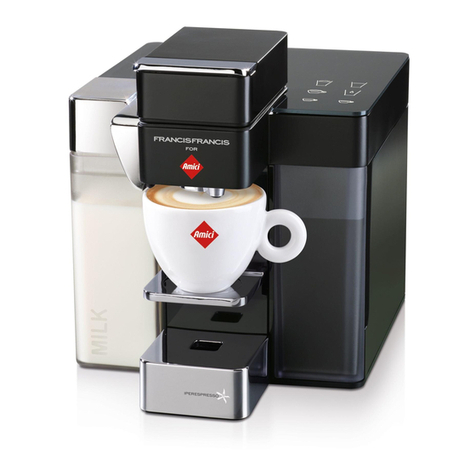
Amici
Amici Y5 MILK IPERESPRESSO instruction manual
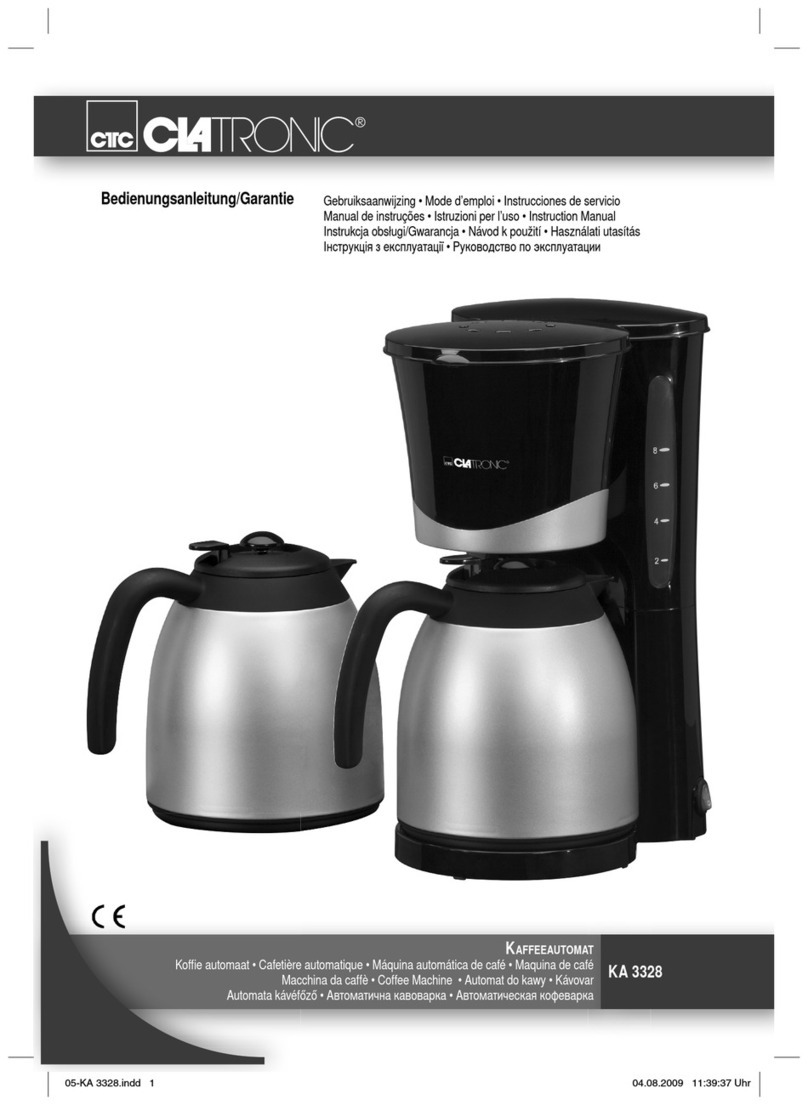
Clatronic
Clatronic KA 3328 instruction manual

Martello
Martello STILISTA PRIMEO instruction manual

Saeco
Saeco HD8761 Quick instruction guide
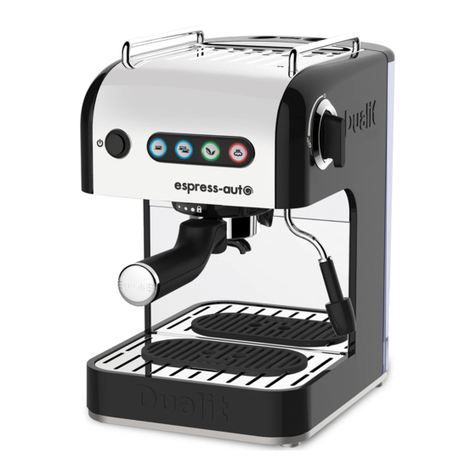
Dualit
Dualit Espress-Auto 3in1 Coffee Machine Instruction manual & guarantee
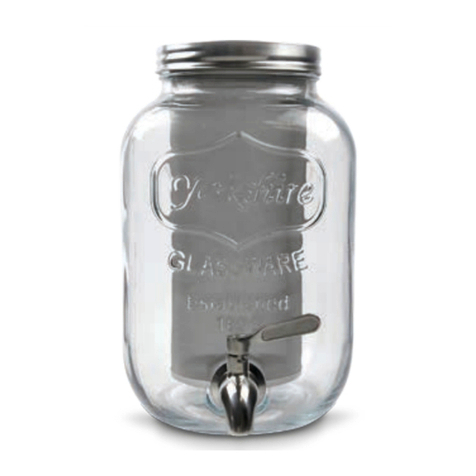
NUTRICHEF
NUTRICHEF NCCOFF87 user guide
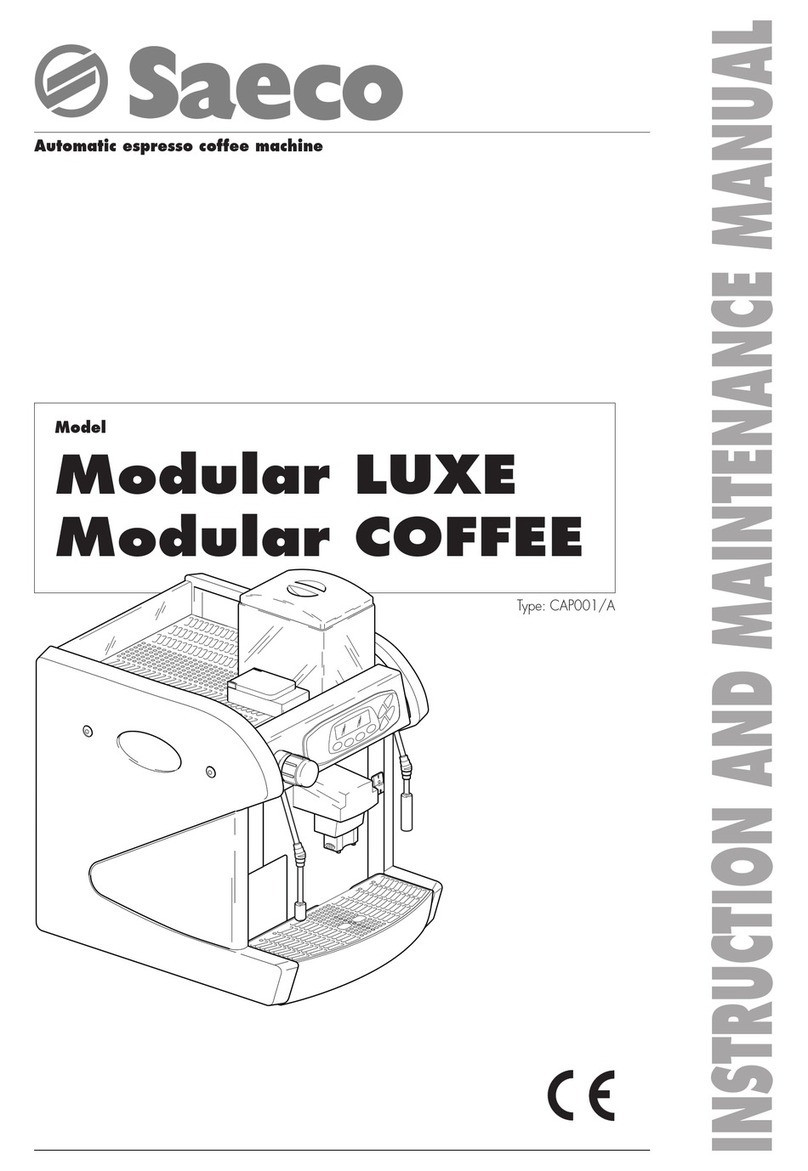
Saeco
Saeco CAP001/A Instruction and maintenance manual
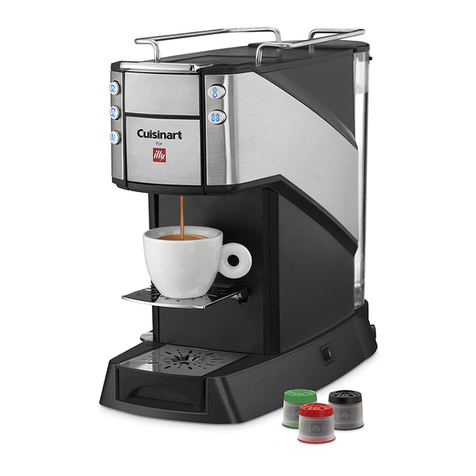
Cuisinart
Cuisinart EM-400 SERIES illy Instruction/recipe booklet

Bremer
Bremer VIVA XXL-T operating instructions

Philips Saeco
Philips Saeco HD9933/11 Specifications
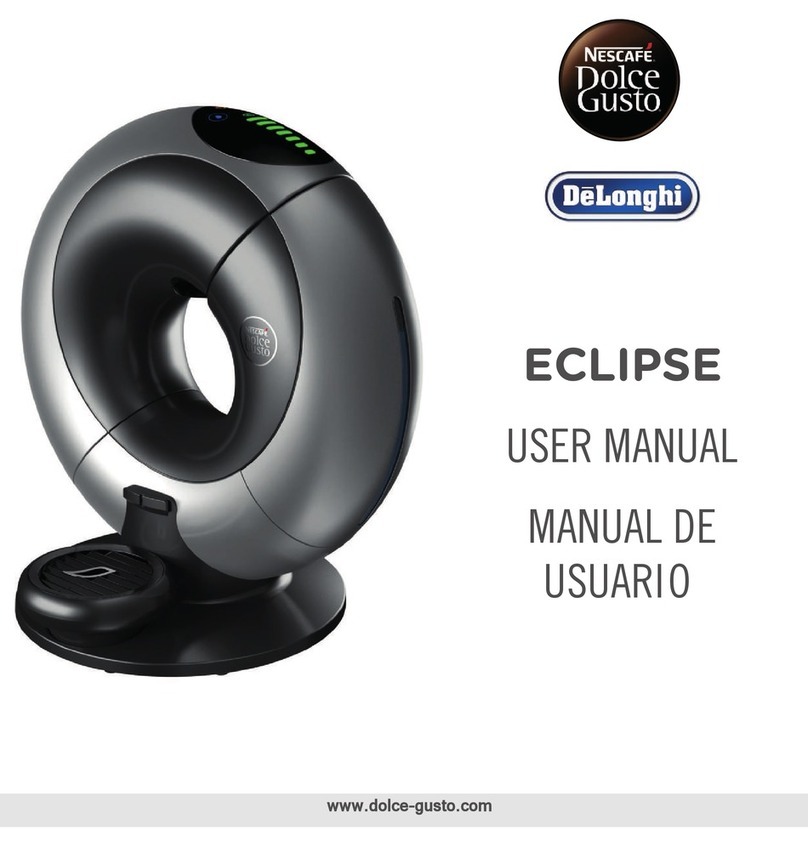
De'Longi
De'Longi ECLIPSE user manual

Breville
Breville Bar Italia ESP4 Instructions for use
